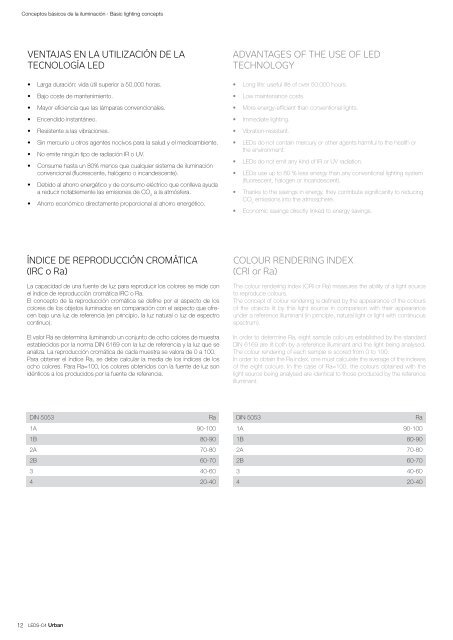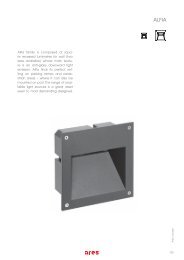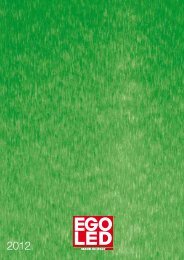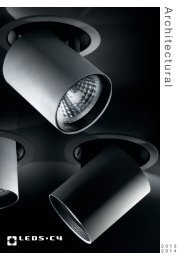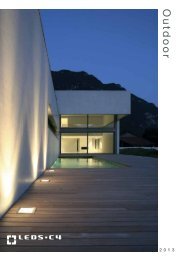You also want an ePaper? Increase the reach of your titles
YUMPU automatically turns print PDFs into web optimized ePapers that Google loves.
Conceptos básicos de la iluminación · Basic lighting concepts<br />
VENTAJAS EN LA UTILIZACIÓN DE LA<br />
TECNOLOGÍA LED<br />
• Larga duración: vida útil superior a 50.000 horas.<br />
• Bajo coste de mantenimiento.<br />
• Mayor eficiencia que las lámparas convencionales.<br />
• Encendido instantáneo.<br />
• Resistente a las vibraciones.<br />
• Sin mercurio u otros agentes nocivos para la salud y el medioambiente.<br />
• No emite ningún tipo de radiación IR o UV.<br />
• Consume hasta un 80% menos que cualquier sistema de iluminación<br />
convencional (fluorescente, halógeno o incandescente).<br />
• Debido al ahorro energético y de consumo eléctrico que conlleva ayuda<br />
a reducir notablemente las emisiones de CO 2<br />
a la atmósfera.<br />
• Ahorro económico directamente proporcional al ahorro energético.<br />
ADVANTAGES OF THE USE OF LED<br />
TECHNOLOGY<br />
• Long life: useful life of over 50,000 hours.<br />
• Low maintenance costs.<br />
• More energy-efficient than conventional lights.<br />
• Immediate lighting.<br />
• Vibration-resistant.<br />
• LEDs do not contain mercury or other agents harmful to the health or<br />
the environment.<br />
• LEDs do not emit any kind of IR or UV radiation.<br />
• LEDs use up to 80 % less energy than any conventional lighting system<br />
(fluorescent, halogen or incandescent).<br />
• Thanks to the savings in energy, they contribute significantly to reducing<br />
CO 2<br />
emissions into the atmosphere.<br />
• Economic savings directly linked to energy savings.<br />
ÍNDICE DE REPRODUCCIÓN CROMÁTICA<br />
(IRC o Ra)<br />
La capacidad de una fuente de luz para reproducir los colores se mide con<br />
el índice de reproducción cromática IRC o Ra.<br />
El concepto de la reproducción cromática se define por el aspecto de los<br />
colores de los objetos iluminados en comparación con el aspecto que ofrecen<br />
bajo una luz de referencia (en principio, la luz natural o luz de espectro<br />
continuo).<br />
El valor Ra se determina iluminando un conjunto de ocho colores de muestra<br />
establecidos por la norma DIN 6169 con la luz de referencia y la luz que se<br />
analiza. La reproducción cromática de cada muestra se valora de 0 a 100.<br />
Para obtener el índice Ra, se debe calcular la media de los índices de los<br />
ocho colores. Para Ra=100, los colores obtenidos con la fuente de luz son<br />
idénticos a los producidos por la fuente de referencia.<br />
COLOUR RENDERING INDEx<br />
(CRI or Ra)<br />
The colour rendering index (CRI or Ra) measures the ability of a light source<br />
to reproduce colours.<br />
The concept of colour rendering is defined by the appearance of the colours<br />
of the objects lit by this light source in comparison with their appearance<br />
under a reference illuminant (in principle, natural light or light with continuous<br />
spectrum).<br />
In order to determine Ra, eight sample colo urs established by the standard<br />
DIN 6169 are lit both by a reference illuminant and the light being analysed.<br />
The colour rendering of each sample is scored from 0 to 100.<br />
In order to obtain the Ra index, one must calculate the average of the indexes<br />
of the eight colours. In the case of Ra=100, the colours obtained with the<br />
light source being analysed are identical to those produced by the reference<br />
illuminant.<br />
DIN 5053<br />
Ra<br />
1A 90-100<br />
1B 80-90<br />
2A 70-80<br />
2B 60-70<br />
3 40-60<br />
4 20-40<br />
DIN 5053<br />
Ra<br />
1A 90-100<br />
1B 80-90<br />
2A 70-80<br />
2B 60-70<br />
3 40-60<br />
4 20-40<br />
12 LEDS-C4 Urban


